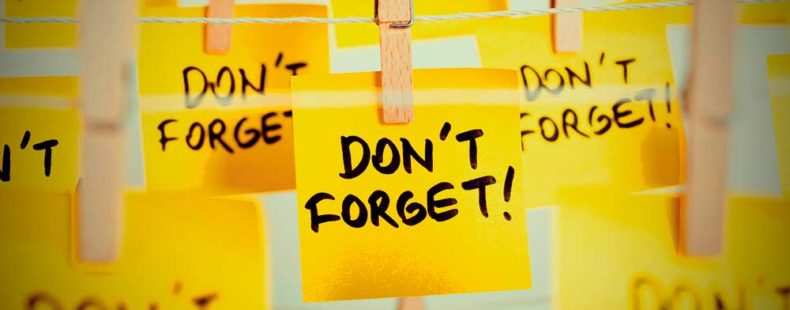What are mnemonics?
Whether or not you loved school, there are several fictitious figures you should thank for your education. Your Dear Aunt Sally, for example, as well as your Very Educated (or Excited, Eccentric, Elephantine) Mother, and Roy G. Biv. Also, be grateful that All Cows Eat Grass; those cows saved your ‘rhymes-with-grass’ in music class.
Has this collection of relatives and cows sent you on a sweaty jog down memory lane? We hope so. Because that’s exactly what these curious names and phrases are meant to do. These mnemonic devices are memory tools of a different sort, used as aids in learning, storing, and recalling information.
Mnemonic (pronounced ni-mon-ik) is from a Greek word meaning “mindful.” The Ancient Greeks cherished the power of the human mind and memory. Mnemosyne, the mythological goddess of memory or remembrance, conceived the nine Muses over nine rambunctious nights with Zeus. If in Greek myth the mother of all inspiration—of literature, science, history, philosophy and the arts—is none other than Memory, it pretty much behooves us to take care of our mental machinery.
So, in tribute to Mneomsyne—a Very Exceptional Mother, indeed—here’s a selection of mnemonic strategy types with old-school examples you’re sure to remember.
What are connection mnemonics?
Connection mnemonics connect the new information you want to learn with knowledge you already have.
- In geography, distinguishing between latitude and longitude lines is made easier because LONGitude runs LONG North to South. Also, LAT in LATitude rhymes with FLAT (latitude lines run flat or horizontal East to West).
- Stalagmites grow on the GROUND; stalactites on the CEILING
What is chunking?
This is one of the largest umbrella strategies for remembering information. Many items are grouped into chunks or categories that can be stored and retrieved using fewer labels. Fewer labels means fewer things to remember, but the labels act as a cue for remembering the rest of the information you want to retrieve. The most common verbal examples are acronyms and acrostics.
Acronyms: The first letter of each word to be remembered forms a single word. Acronyms are great if the order of information is not important.
- FANBOYS is for coordinating conjunctions: for, and, nor, but, or, yet, so
- HOMES is for the Great Lakes: Huron, Ontario, Michigan, Erie, Superior
- ROY G. BIV is for colors of the rainbow: red, orange, yellow, green, blue, indigo, violet
Acrostics: Easier-to-remember words that begin with the same first letter of each item you’re trying to remember. These are configured to make a (usually silly) sentence. Acrostics are especially useful when the order of information is important.
- King Philip Came Over For Great Spaghetti: this is the order of taxonomy in biology (kingdom, phylum, class, order, family, genus, species)
- Please Excuse My Dear Aunt Sally: this is the order of operations in math (parentheses, exponents, multiplication, division, addition, subtraction)
- My Very Educated Mother Just Served Us Nachos: this is the order of plants starting with the nearest to the sun (Mercury, Venus, Earth, Mars, Jupiter, Saturn, Uranus, Neptune)
- I Value Xylophones Like Cows Dig Milk: this is the Roman numeral values in increasing order (I=1, V=5, X=10, L=50, C=100, D=500, M=1,000)
How do you use rhymes to remember?
Often, putting information in the form of a rhyming poem aids recall. The repetition of sounds in childhood nursery rhymes helps young language-learners acquire words and patterns. The same came be said of older learners.
- “30 days hath September, April, June, and November. All the rest have 31, but February’s the shortest one. With 28 days most of the time, until Leap Year gives us 29.”
- “In 1492, Columbus sailed the ocean blue.”
What is linking or chaining (images and stories)?
These strategies, along with acrostics, are probably the most fun. Individual items are linked or chained together in a screwball story, in which words and concepts interact in a fantastical way. Drawing a picture to support the story can help solidify the memorization, but the most important thing is to create a vivid mental visualization of the narrative (like a movie). Usually the more bizarre the better.
Here’s an example (not from school-days of yore). Say you want to learn the body’s excretory organs: liver, intestines, kidneys, skin, lungs. A chain could go something like this:
“Lilliput loved liver so much she burst her intestines multiple times. To boot, her kidneys hurt whenever she looked at her skin, which got pimply. So, she started smoking, because, heck, why not ruin her lungs while she’s at it.”Want to remember more of those fun school-day acronyms and acrostics you used when cramming for those weekly spelling tests? Take a look at our list that proves Spelling Still Matters.














